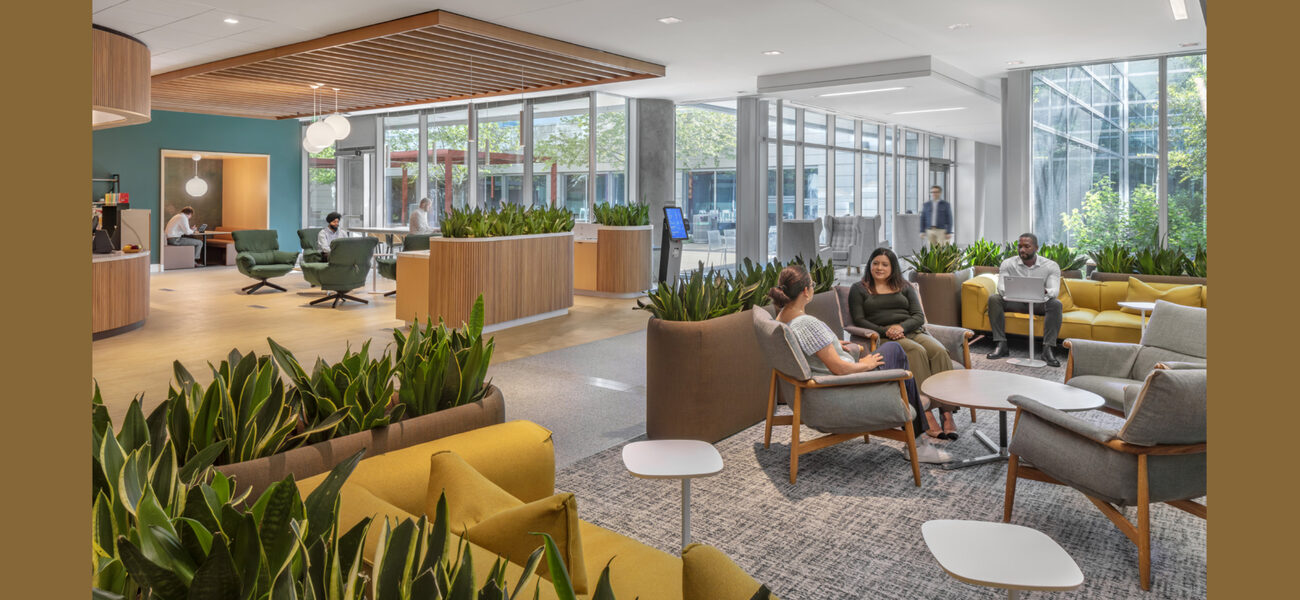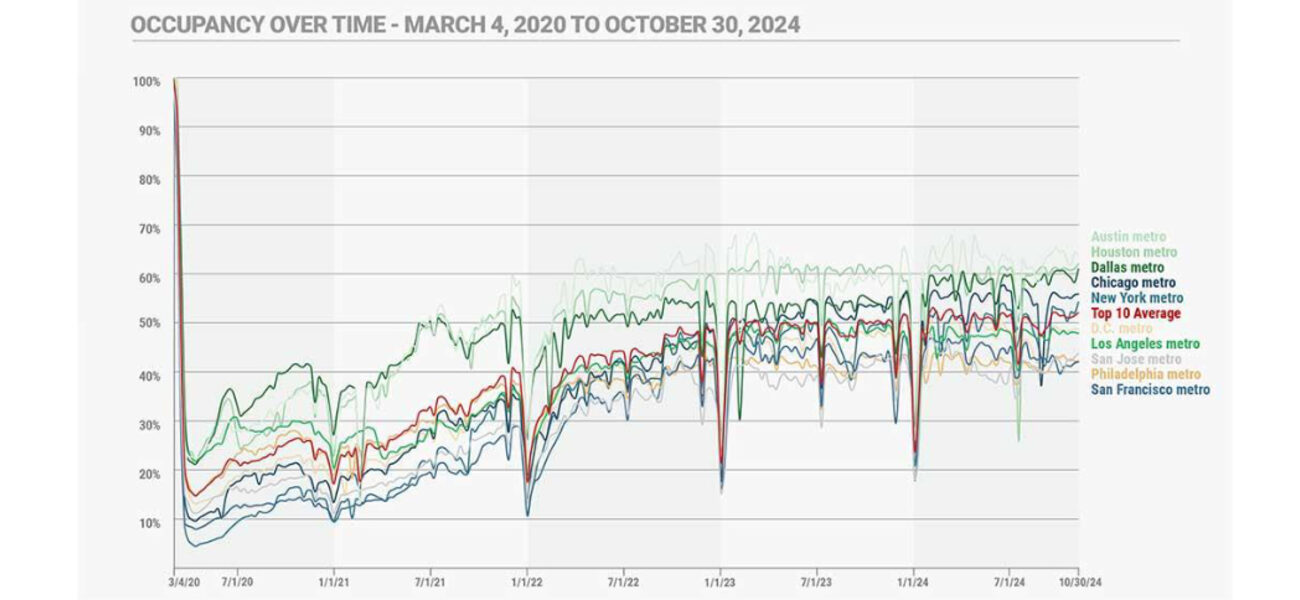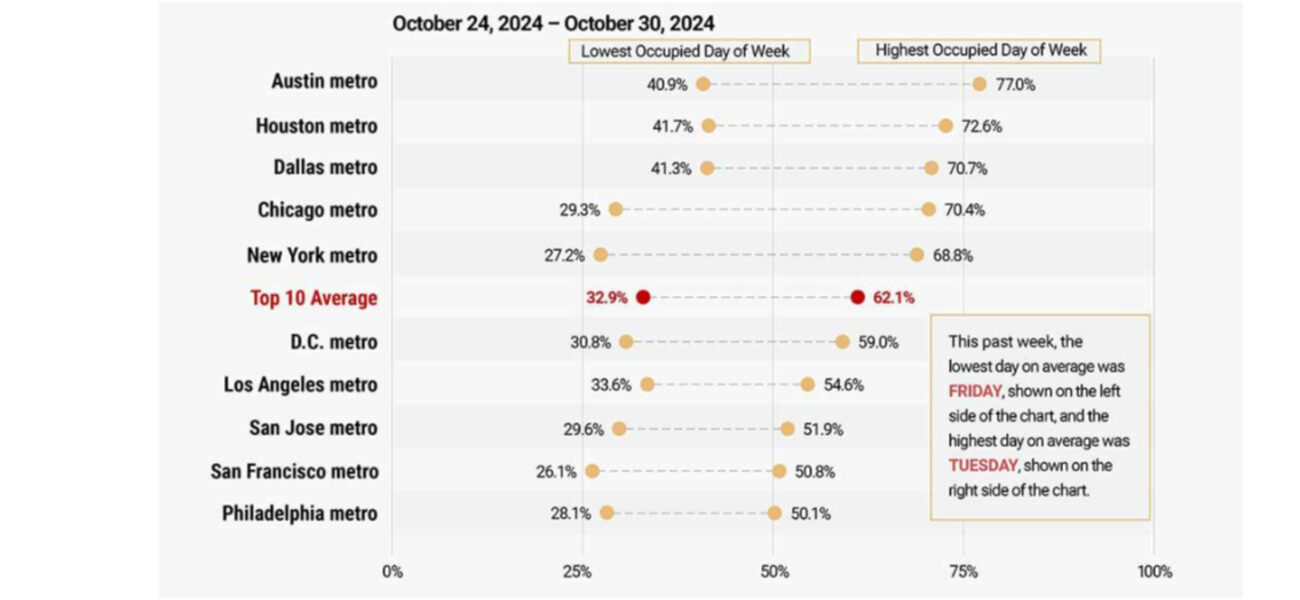Three years after the end of the pandemic, office occupancies have still not gone back to where they were pre-COVID, and there is a wide range of opinions about whether they should. While some executives have ordered everyone back into the office, arguing that being physically present facilitates engagement and innovation, many workers argue that their working life and their home life are better when they can choose where they log on. Kelly Bacon and Jeannette Peruchini, workplace experts for AECOM, the global design and engineering firm, discuss what’s changed in the working environment and different ways of creating the office culture and working space that are right for your organization.
Where We Work Now
Pre-COVID, remote work was already growing, but slowly. Office occupancy stood at about 65% most days.
After COVID hit and the country locked down, the number of people working at home skyrocketed, and many organizations trimmed their footprints.
As the country opened up again, many companies stuck with a remote working model, while others mandated three days back in the office. More recently, many organizations have told workers they need to come back full-time, according to Peruchini, managing principal, U.S. West Interiors practice leader for AECOM.
On average, most offices are about 50% occupied on any given day in the U.S., but the total amount of office space in use has fallen dramatically. Over 20% of American offices are vacant today, according to Cushman & Wakefield data, compared to 13% in 2019.
Tuesdays through Thursdays remain the peak in-office days, with occupancy rates of up to 80% in some offices, but on Mondays and Fridays, attendance is often as low as 20-30%.
This has led to some major changes in space allocation, which stood at about 1.2 staff per desk pre-COVID but has increased to 2 people per desk today. In particular, space planners are looking for:
- Connection spaces—larger rooms where people can come together to work through a set of problems for hours or weeks, or to provide a community where peers can help spark new ideas. Some companies are mandating tech-free zones, where people can have a conversation with no screens.
- Head-down spaces—quiet places that may or may not be private, where people are able to work quietly. These aren’t necessarily closed spaces, says Bacon, but, like quiet cars on Amtrak, are set aside for quiet work.
Coming Back or Staying Home?
The executives who want people back argue that working together in person creates deeper personal connections and makes it easier to collaborate, attributes that translate to more innovation, enhanced mentorship, and a stronger culture.
Peruchini quotes a Disney executive who said the company went back to working in person because, “In a creative business like ours, nothing can replace the ability to connect, observe, and create with peers. This comes from being physically together.”
Amazon CEO Andy Jassey has also said, “There’s something about being face-to-face with somebody, looking them in the eye, and seeing that they’re fully engaged and immersed in what you’re discussing, that brings you together.”
But many employees, particularly women, have resisted calls to go back to the office. Some say they are more productive working at home. They also enjoy having a shorter commute and a better work-life balance. “The commute time is a big one. If you don’t have to commute there and back, you can get much more time back in your personal life,” notes Peruchini.
Technically, too, flexibility keeps getting easier. “The better our technology gets, and the more mobile our tools, the more working from anywhere has been enabled,” says Bacon, vice president, principal, and strategy lead for AECOM’s Buildings and Places practice.
Major landlords are also finding ways to be more flexible with office space. The General Services Administration in the federal government, for example, is now working with Liquid Space, a software company that allows people in one department to sublet available space from another department on a short-term basis.
Despite the well-publicized calls from the Oval Office on down mandating workers go back to the office fulltime, the AECOM experts don’t think hybrid work will be a fad. “I do think that it’s absolutely here to stay, and that it will continue to be if your work allows you to have that flexibility,” says Bacon.
Rationalizing space helps keep rental costs down and meet carbon reduction goals: 30% of carbon emissions come from buildings, according to AECOM figures.
Mandate vs. Magnet
How should organizations decide? Peruchini argues that the leader should simply decide—issue a mandate and tell people to show up.
“I think we all need structure,” says Peruchini. “If I could eat ice cream every single day, I would. I absolutely would, but I know that I shouldn’t, and so I don’t. As individuals, if we are given the opportunity to do whatever we want, whenever we want, the structure starts to break down a bit and it gets lost.”
Instead of having a vague sense that they can work from home three days a week, Peruchini argues that people find it easier when they are given clear guidelines. “I find that people do want some structure. They want to understand what the policy means and what the expectations are.”
A mandate can also solve a common coordination problem between colleagues. “If I go in on a Monday and no one else wants to go in on a Monday, what is the purpose of me being there?” asks Peruchini.
But Bacon argues that there is something to be said for giving individuals choice, and letting teams make the decision that is right for the team—making the office a magnet rather than a mandate. If their work can be done best in the office, she says, they’ll come.
“Make it about the work; make it about the people,” advises Bacon. “Take a look at your new-hire schedule. Take a look at your project schedule: I have projects X, Y, and Z. These are the milestones. Work backwards and have teams put together a plan—‘We’re going to come into the office for this week, or we’re going to come in for this project or this new hire,’” she says.
For the office planner, the magnet approach has a major advantage in that over time, says Bacon, “we can gauge occupancy, and we can properly plan how much space we actually need.”
Whether you conduct your space use policy by mandate or magnet, if you eventually reallocate office space, don’t overlook the change management challenge that such changes can entail. For law firm partners, for instance, larger bonuses can be a big compensation for a smaller office. Further down the ladder, a new perk, such as a better coffee machine or a free lunch, might go a long way toward building good will toward the new design, says Peruchini.
Weighing the Evidence
Whatever the method, do some research about actual usage patterns before making a decision about space usage. Simply asking people what they need is of limited value. “It may not always be what the reality is,” cautions Peruchini.
One reason is that in traditional industries, for example, such as a law firm, the size of the office tends to be correlated with seniority.
Instead, Peruchini and Bacon suggest collecting data about when and how people are using your space. “You should always look at multiple sets of data,” says Bacon, ticking off a variety of possible data sources, including building security badge swipes, IP logins from smart light fixtures, and occupancy sensors.
Peruchini warns against over-reliance on a single source of data, because it may be less than reliable. “Have you all heard about the swipe and grab? People come in, they swipe, they grab their coffee, they say hello, and then they’re out,” she says. In this case, the swipe count is not an accurate reflection of how many are actually working in-house that day.
It’s also critical to think about what makes sense for your organization’s particular culture. “It’s important to understand how they get their work done, what their company vision is, what is the culture they’re trying to achieve, because it really is about the people,” adds Peruchini.
Whether you are more on the mandate or the magnet side of the debate, a close look at the data and the organization are crucial. “There’s no one right answer,” says Peruchini. “It really depends on the culture, the individuals, and the type of work.”
By Bennett Voyles


